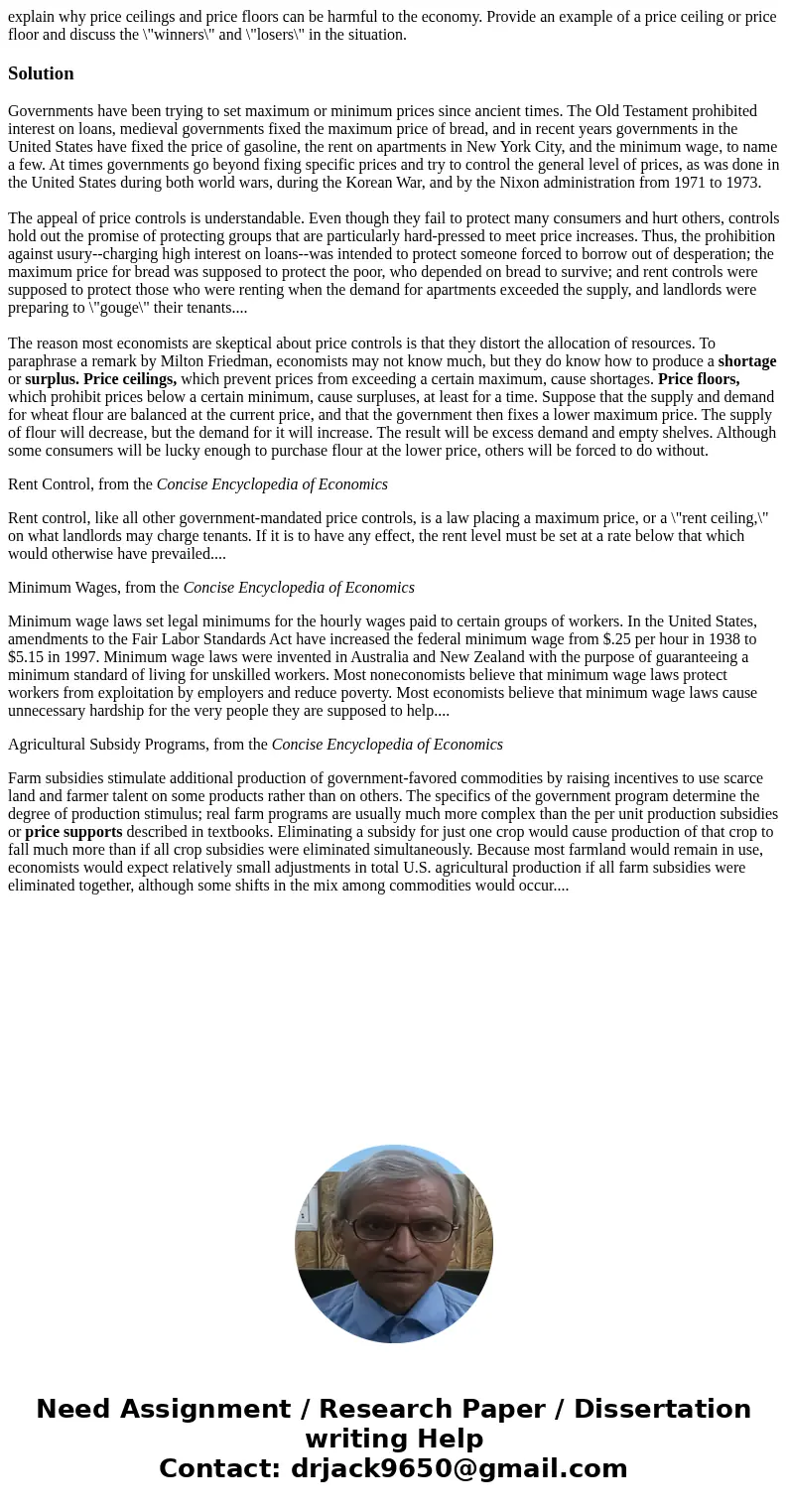explain why price ceilings and price floors can be harmful t
explain why price ceilings and price floors can be harmful to the economy. Provide an example of a price ceiling or price floor and discuss the \"winners\" and \"losers\" in the situation.
Solution
Governments have been trying to set maximum or minimum prices since ancient times. The Old Testament prohibited interest on loans, medieval governments fixed the maximum price of bread, and in recent years governments in the United States have fixed the price of gasoline, the rent on apartments in New York City, and the minimum wage, to name a few. At times governments go beyond fixing specific prices and try to control the general level of prices, as was done in the United States during both world wars, during the Korean War, and by the Nixon administration from 1971 to 1973.
The appeal of price controls is understandable. Even though they fail to protect many consumers and hurt others, controls hold out the promise of protecting groups that are particularly hard-pressed to meet price increases. Thus, the prohibition against usury--charging high interest on loans--was intended to protect someone forced to borrow out of desperation; the maximum price for bread was supposed to protect the poor, who depended on bread to survive; and rent controls were supposed to protect those who were renting when the demand for apartments exceeded the supply, and landlords were preparing to \"gouge\" their tenants....
The reason most economists are skeptical about price controls is that they distort the allocation of resources. To paraphrase a remark by Milton Friedman, economists may not know much, but they do know how to produce a shortage or surplus. Price ceilings, which prevent prices from exceeding a certain maximum, cause shortages. Price floors, which prohibit prices below a certain minimum, cause surpluses, at least for a time. Suppose that the supply and demand for wheat flour are balanced at the current price, and that the government then fixes a lower maximum price. The supply of flour will decrease, but the demand for it will increase. The result will be excess demand and empty shelves. Although some consumers will be lucky enough to purchase flour at the lower price, others will be forced to do without.
Rent Control, from the Concise Encyclopedia of Economics
Rent control, like all other government-mandated price controls, is a law placing a maximum price, or a \"rent ceiling,\" on what landlords may charge tenants. If it is to have any effect, the rent level must be set at a rate below that which would otherwise have prevailed....
Minimum Wages, from the Concise Encyclopedia of Economics
Minimum wage laws set legal minimums for the hourly wages paid to certain groups of workers. In the United States, amendments to the Fair Labor Standards Act have increased the federal minimum wage from $.25 per hour in 1938 to $5.15 in 1997. Minimum wage laws were invented in Australia and New Zealand with the purpose of guaranteeing a minimum standard of living for unskilled workers. Most noneconomists believe that minimum wage laws protect workers from exploitation by employers and reduce poverty. Most economists believe that minimum wage laws cause unnecessary hardship for the very people they are supposed to help....
Agricultural Subsidy Programs, from the Concise Encyclopedia of Economics
Farm subsidies stimulate additional production of government-favored commodities by raising incentives to use scarce land and farmer talent on some products rather than on others. The specifics of the government program determine the degree of production stimulus; real farm programs are usually much more complex than the per unit production subsidies or price supports described in textbooks. Eliminating a subsidy for just one crop would cause production of that crop to fall much more than if all crop subsidies were eliminated simultaneously. Because most farmland would remain in use, economists would expect relatively small adjustments in total U.S. agricultural production if all farm subsidies were eliminated together, although some shifts in the mix among commodities would occur....

 Homework Sourse
Homework Sourse